If you listen to vinyl on an MM cartridge, you'll be one of many very shrewd people that prefer to think about the value of their hifi purchases, rather than the expense. For many years, the market for phono-audio cartridges has been deliniated between Moving Magnet and Moving Coil types, with moving coil sitting at a much higher price point. There are some excellent MM carts available, but they all suffer from the same problems of eneven frequency response, phase shift and cross-talk.
ZinAmp's Active Cartridge system - Z-ACT - is designed to eliminate these problems from your MM cartridge, unlocking it's potential to sound as good as an MC, but with all of the practical and cost benifits of MM ownership.
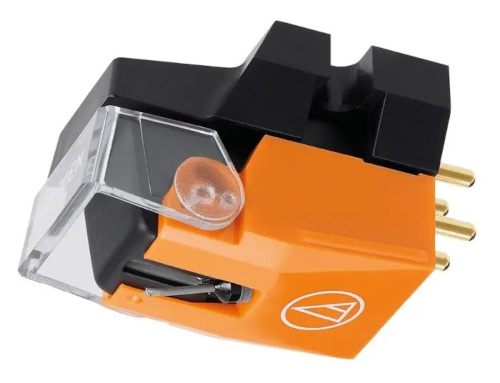
Audio Technica VM530EN Moving Magnet Cartridge
MM vs MC - pros & cons
It's fairly well accepted that MM carts are less expensive than their MC counterparts. Most MM models allow the stylus tip to be replaced and can be used with standard phono-equipment. MC carts - conversly - are more expensive, have irreplacable stylus tips and require a head-amp or step-up transformer to play them.
So what are we getting for our investment? Conventional wisdom among audio enthusiasts and the audio press suggests MC sounds better. Interestingly, this is one area of audio that is fairly easy to substantiate with technical data. MC carts have less cross-talk, less phase-shift and in some situations, lower noise. But does that make them better? If price is no object and sound is everything, then yes, MC does generally sound better - for those reasons.

Ortofon Quintet Blue MC Cartridge
Price Points:
If we go with the idea that we get what we pay for, then it's fair to say an MC is a good investment, as long as you can afford the cartridge, the equipment and don't mind paying for an entire new cart when it's worn out. However, when MM carts start at £30 and MC start at £300, there is a valid question to be asked about what we're getting for our money. Add to this that there are MM carts that exceed £1000. What's special about those? Are they better than MC carts for £300? To answer this properly, one has to look closely at the real differences between MM and MC - and that means forgetting about (for a moment) their respective price points.
MM and MC - electrical differences - in a nutshell:
Nearly all modern carts utilise a diamond tip on the end of a cantelever, which is usually made from lightweight metal. There are exceptions; some cantelevers are made from diamond, ruby or even sapphire, but they all do the same job; that is to harness the kinetic vibration of the diamond tip as it moves through the grooves of the record. This kinetic energy is translated into an electrical signal inside the cart body - known as the cartridge 'motor'. With MM, this is a pair of tiny magnets on the end of the cantelever that move inside a pair of large coils (l & r for stereo). With MC, it's is a pair of small coils on the end of the cantelever and these move around a larger magnet or magnets.
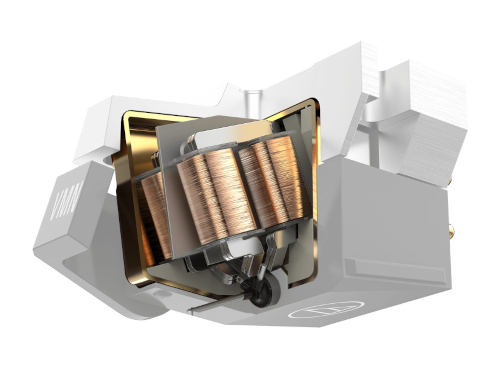
MM Cart - Internal Construction
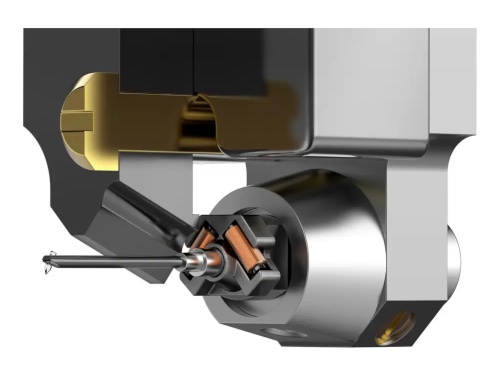
MC Cart - Internal Construction
The difference between MM and MC is the size of coil and size of magnet. With the MM cart the coil is bigger, has more windings and as the electically minded will appreciate, has a higher inductance. It has a higher output signal, but has a higher output impedence - and this means it's vulnerable to the effects of cable capacitance.
An MC cart has a much smaller coil with fewer windings. This means is has a lower output signal, but it also has a lower inductance and a lower output impedence...and this is why it sounds better!
You might be forgiven for thinking this sounds like marketing bunkum. We've just introduced two technical terms; coil inductance and output impedence - and then claimed that MC sounds better! Surely this warrants a brief explaination about why these things matter and how they affect sound.
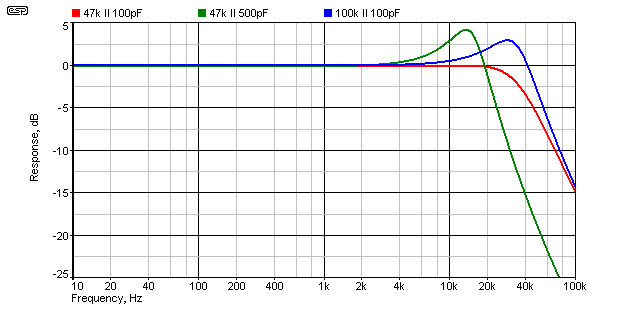
Response of an MM Cart tends to rise with frequency. This can be damped with capacitance.
If you're not electrically minded and care little about these things, then the simplest way to think about it is that the size of signal coming from an MM cart is changing with frequency. That means from low bass notes, through the mid-range onto the treble notes, the coil's resistance (and therefore the siganl we can extract from it) is changing. This is why some MM carts sound bright, some sound dull and why some have unwanted humps in the mid-range. I.e. they can have an uneven frequency response. MC carts don't suffer from this because their inductance is much lower.
If you're wondering how a cartridge technology - like MM - that has been popular for so may years can have such key flaws, like uneven frequency response, then it's worth considereing that many of us have grown up with and become accustomed to this sound as "normal" for vinyl. Things are perhaps not all that bad though. We can tame the uneven response of an MM cart by adding a small capacitive load to the input of our phono amp. Many phono-stages allow this to be changed and most carts have a recommended capacitance loading. So, probelm solved then? Well, kind of, but the turntable cables add their own capacitance. so the actual loading you need must factor in the cable capacitance. Most turntable cables add about 50pF (picofarads). If your cart requires 100pF and we select 50pF on the phono-amp, then the 50pF in the cables gives us 100pF. Sounds simple enough, but that's a big generalisation, because cables vary in their capacitance due to their length and their construction. It's practically impossible to measure accurately and therefore any attempt to set the capacitance load for an MM cartridge is guesswork. You really have you let your ears decide.
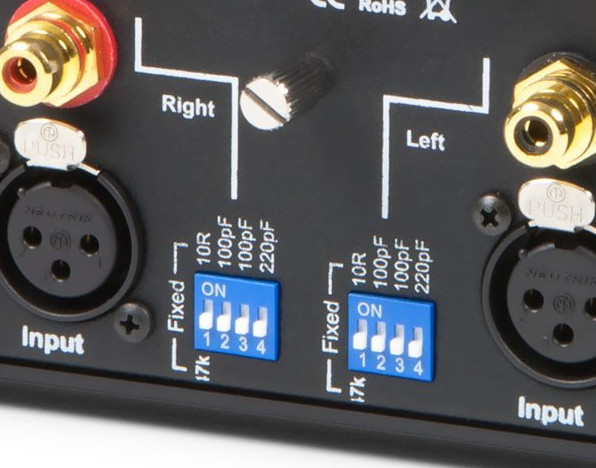
Capacitive Loading Switches, as found on the back of an MM Phono-amp
It gets worse before it gets better! We mentioned MM carts have a higher output impedence. What does this mean? Well, it means the signal has less current to help it travel along the cable to the phono-amp. This means it's more affected by the cables themselves so the signal can become polluted by noise (hum) and other radio-frequency inteference, as well as crosstalk (signal bleed) between the left and right channels, which eats into our stereo image. The final nail in this electrical coffin is the capacitance we added to smooth out the response hump forms a filter with the inductance of the cartidge coil - and this results in phase-shift. This phase-shift can't be removed i.e. we're stuck with it! Its effect is to obscure detail in the all-important upper-mid-range and is often referred to as 'smear'. It's not sounding very promising is it!?!
All MM carts - regardless of price - suffer from these fundamental electrical problems. So if you were thinking of spending £1000 or more on an MM cartridge and are now thinking this might be a waste of money, then we would be inclined to agree with you!
So, would your hard-earned cash be better spent on a £500 MC cart? Well, perhaps. The £500 MC cart will probably sound better as it is unfettered by all of the irritating electrical problems of MM. You do need to spend more money on a head-amp or step-up transformer and this may give you little or no change from the other £500! Added to that, when it wears out, you have another £500 bill, give or take inflation!
Price-points of MM and MC cartridges
To answer this important question properly, let's look at what you get for your money when you buy a cartridge. The main cost differentiators are whether its MM or MC, the cantelever and the diamond tip. We're going to ignore cantelevers here, because it is much harder to assert whether an aluminium cantelever sounds better than one made from boron, diamond, sapphire or whatever. You have to take into account compliance, tonearm mass, resonance and other effects to know whether the cantelever is really making a difference. In most cases, it's not as relevant as the stylus tip and whether the cart is MM or MC, so we will stick with those simple attributes for now:
Most manufacturers offer a range of tips with diamond types similar to the list below (with approx price points for MM and MC equivalents):
Type | MM | MC |
| Conical | £30 | N/A |
| Elliptical Bonded | £80 | £300 |
| Nude Elliptical | £120 | £400 |
| Microlinear | £300 | £500 |
| Shibata | £400 | £600 |
| Line Contact | £600 | £800 |
Note: There are only a few MC carts with conical tips available - hence N/A for this type
This list is largly based on Audio Technica's catalogue, but most manufacturers like Ortofon offer a similar range; with some esoteric exceptions. Conical is the cheapest diamond to cut and was the common standard up to about 1970. As diamond cutting techuiques have improved, new profiles like the elliptical stylus have become standard. In the mid 1970s, the Shibata stylus was developed to work with quadraphnic stereo. These records had very high frequency signals outside of the audio band and the Shibata diamond could extract these with little error. This technology caught on in mainstream HiFi and there are a number of very good Shibata stylii available now. Microline and Line Contact are more recent developments; made possible by laser cutting techniques. Microline is known for it's ability to extract trebles very well and for that reason is regarded as 'bright' sounding. Line Contact tends to be much more expensive than Shibata, but the benifits are hard to discern, given the price.

A selection of common types of diamond stylus tip
In short, the more carefully cut diamond tips costing more money are better at tracing the groove wall. You're more likely to hear differences between stylus tips toward the end of a record, where the groove radius is smaller and therefore cartridge alignment is more critical. With a tight groove radius (i.e. at the end of a record), a diamond that can trace the groove wall more closely will have less inner-groove distortion. This is the simplest way to assess what you're getting for your money. If you're comparing different cartridges, listen to the last song on the side to hear how well it traces the groove.
The prices quoted above are quite broad but fairly typical. You can see that the MC market spreads out at higher price points. This is perhaps to be expected in a market known for it's 'upgrades'.
So how do we ensure getting the best value for money? Just buy an expensive MM? Just buy a cheap MC? Is there a way to get the best of both worlds? The short answer is 'yes', there is.
We can actually get the best of both worlds by using an MM cart and fitting it with an active cartridge system. ZinAmp's active cartridge system (called Z-ACT) is exacly that. Here's how it works?
By placing a small amplifier in the headshell, we can lower the output impedance of the cartridge and this eliminates the effects of the cable capacitance, so all of our MM issues are eliminated in a stroke:
- Cross-talk is reduced i.e. a wider stereo image
- Less noise and hum picked up by the cables
- Frequency humps and dips are eliminated
- Phase-shift or 'smear' is removed
The amplifier doesn't make the cartridge louder, but it gives the signal coming from the cartridge more current.
By small amplifier, we mean a small PCB weighing about 1g and about the size of an adult thumb-nail. It's powered using phantom power. This is a low voltage and current that comes up the turntable cables from a phantom power supply that sit's between the turntable and the phono-amp. It adds no colour nor distortion to the sound. It simply adds a small voltage and current to the cable - this is what powers the small amp behind the cartridge.

Z-ACT Headshell Amplifier - fitted inside a headshell
There is no need to modify the rest of the turntable. The small amplifier can either be fitted in the headshell or to the back of the cartridge. It's very simple to connect using the existing tonearm wires - it literally works with any turntable and MM cartridge.
So what does it sound like:
It's tempting to say it sounds like an MC, but we'd prefer you to be the judge. The comments we have received from customers so far have ranged from 'I didn't expect such a night-and-day difference' to 'I can't go back to normal MM now'. These are indeed encouraging, but the reality is that these problems that blight MM are real. They are so real, that what you eliminate them with Z-ACT, it's very obvious and very noticable.
Z-ACT is priced at £449. For this, you get the phantom power supply and the headshell amp. The headshell amp is available to fit a range of headshells or cartridges and can be made to work in alomst any configuration. We also offer Z-ACT as an optional upgrade to our Phono stages at £299. If you appreciate value and you want the very best from your listening experience, we think you'll be very happy with Z-ACT.



